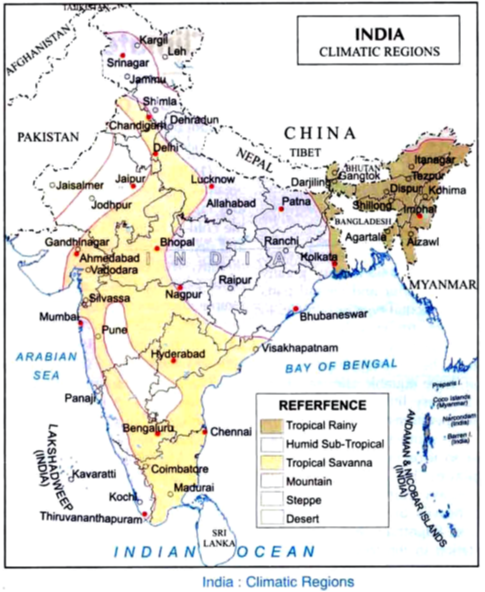- Books Name
- CBSE Class 6 Social Science Book
- Publication
- Param Publication
- Course
- CBSE Class 6
- Subject
- Social Science
CYCLE OF SEASONS IN INDIA
(1) The Cold Weather Season – The cold weather season starts in India in early December and lasts upto February. January and February are the coldest months. Then temperature remains cool and dry. It is cool because the sun's rays do not fall directly. The atmosphere is dry because the winds blow from the land and have no moisture. The temperature decreases from south to north. It varies from 10°C to 25°C. Temperature is between 10°C to 15°C in the northern India and about 25°C in the southern India.
During winter the north-east monsoon winds blow over India. A high pressure area develops in the northern plains due to cold climatic conditions from where the winds start blowing towards the areas of low pressure over the sea. While passing over the sea (Bay of Bengal), they pick up moisture and cause heavy rainfall on the coast of Tamil Nadu during this season. The second region to receive rainfall in winter is the north-west part of India. It receives rainfall from the 'Western Disturbance
(2) The Hot Weather Season – This season lasts from March to May. It is very hot during this season because the sun shines vertically over India. The highest day temperatures occur in the Deccan Plateau (38°C), Gujarat (43°C) and north-west of India (48°C) respectively. The rising temperature leads to the formation of low pressure area in the north-west of India. Because of this low pressure the moist winds from the Arabian Sea begin to blow towards land and cause pre-monsoon showers in Chhota Nagpur, Kerala and Western Ghats. But the north-west areas remain dry and hot winds, called 'loo', engulf the whole area. Sometimes dust storms in the Punjab, Haryana and U.P. are followed by light rain and cool breeze which lower the temperature to a great extent.

3. South–West Monsoon Season or Advancing Monsoon Season – During the months of June to September the south-west monsoon winds blow northwards in two branches from the Arbian Sea and the Bay of Bengal. They give rainfall to the whole of northern India. The winds blow from the oceanic high pressure areas towards the low pressure areas of the land and give heavy rainfall. The Arabian Sea branch causes heavy rainfall, exceeding 300 cm along the coastal area of the Western Ghats, but this rainfall decrease as the monsoons go further. Thus the Deccan Plateau and the Eastern Ghats receive less rainfall as they are situated in the rain shadow area.
(4) The Retreating Monsoon Season – This season runs from October to November. In this season the sky is usually clear and humidity is low. At this time the monsoons start retreating. The months of October and November form a period of Insnsition from hot rainy season to dry winter condition. The lower temperatures on the plains give rise to gradual increase in pressure and as such the monsoons retreat from most part of North India. Tamil Nadu receives high rainfall from these winds during this period (winter). The retreating monsoons are laden with moisture when they pass over the Bay of Bengal and cause rainfall in Tamil Nadu.

 Param Publication
Param Publication
